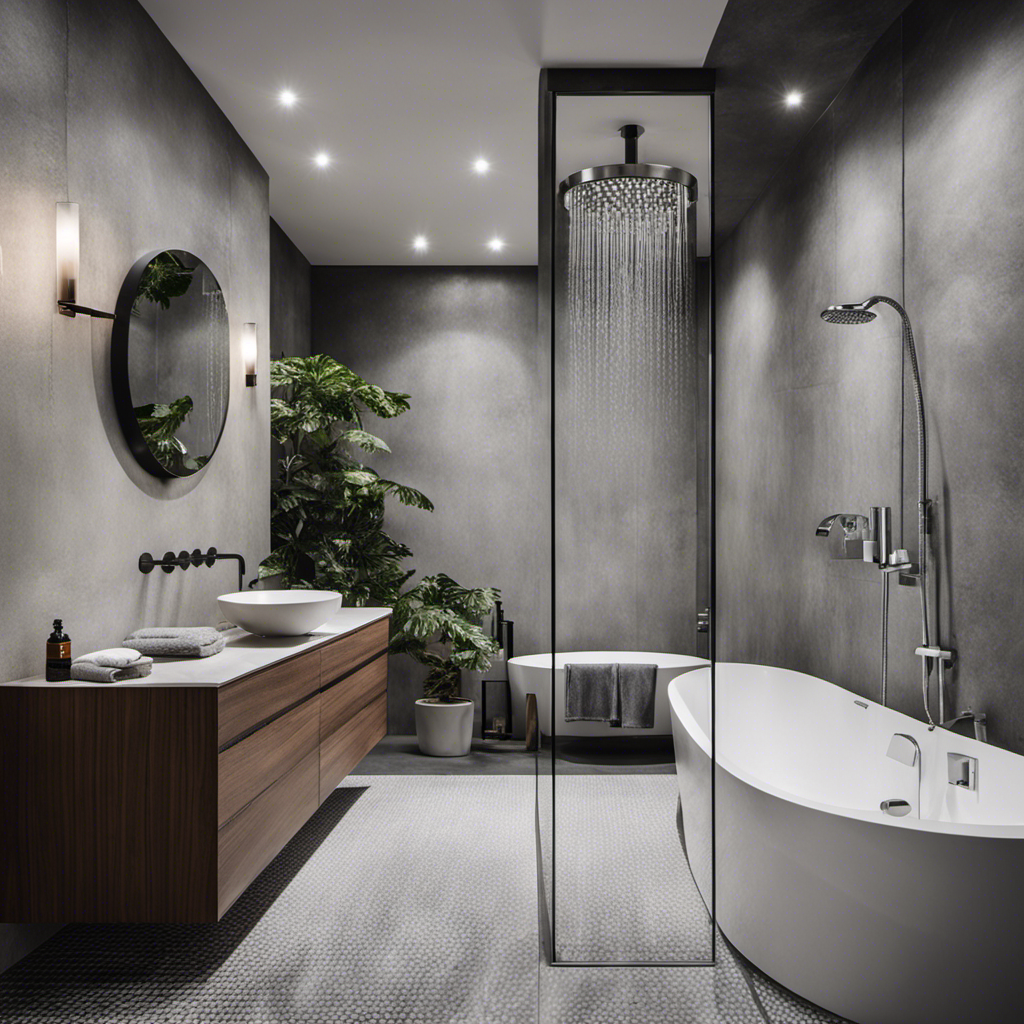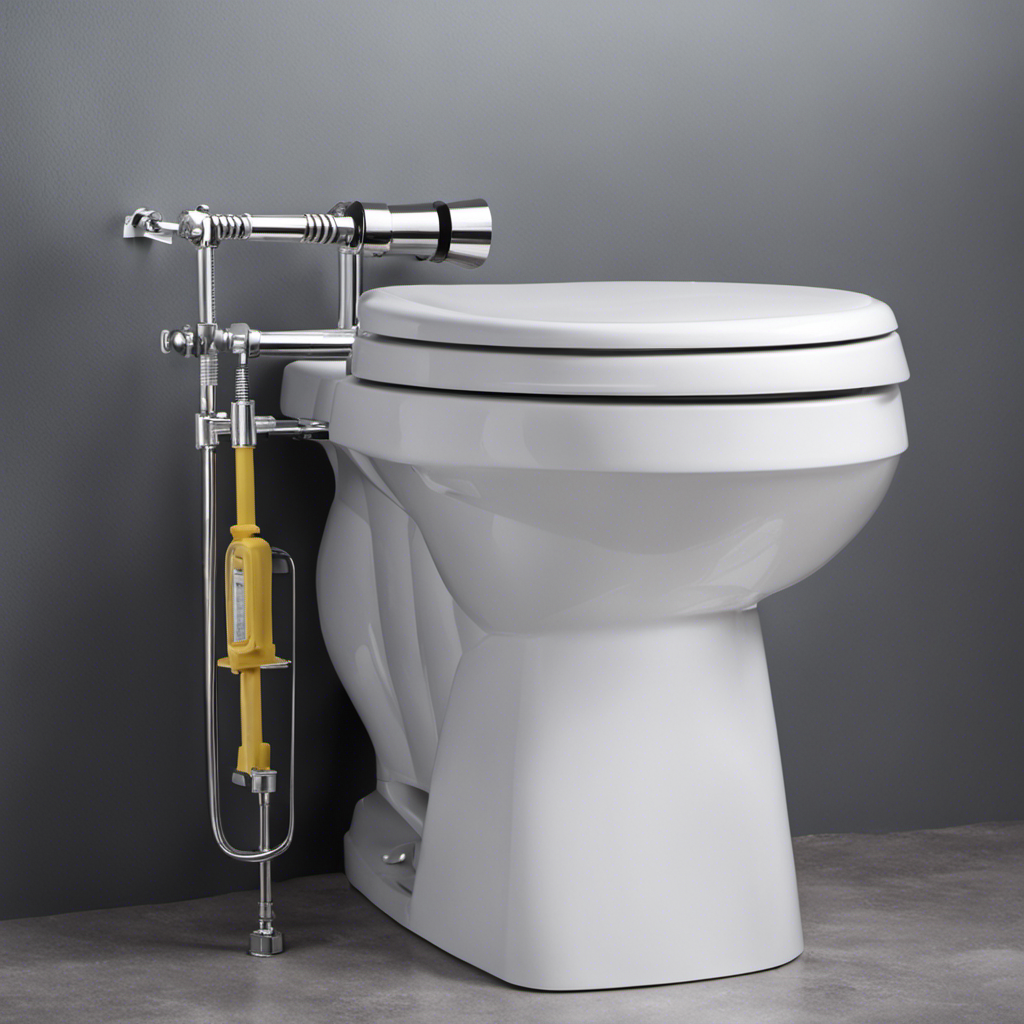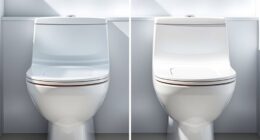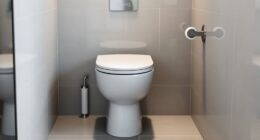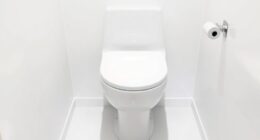Unveiling the secrets behind whistling showerheads, this article dives into the causes and solutions for this pesky problem.
Discover why dirt and limescale buildup, faulty water pipes, and even a fresh coat of paint can lead to that annoying whistle.
But fear not, for there are solutions at hand. From cleaning cartridges and using vinegar to break down limescale, to checking for pipe faults and increasing pipe size, this article will guide you through the steps to silence your shower.
Key Takeaways
- Whistling showerheads can be caused by dirt in the cartridges, limescale buildup, faulty water pipes, or painted showerheads.
- Solutions for whistling showerheads include cleaning the cartridges, using white vinegar to remove limescale buildup, checking for faults or clogs in water pipes, removing paint from the showerhead, and replacing narrow pipes.
- Showerheads wear out over time due to use and limescale buildup, and regular maintenance and cleaning can help prolong their lifespan.
- To replace a whistling showerhead, spin the old one counterclockwise to remove it, secure the shower arm to the new showerhead using plumber’s tape, attach the new showerhead by turning it clockwise, and ensure a tight and secure connection to prevent whistling noises.
Causes of Whistling Showerheads
Dirt getting stuck in the cartridges and limescale buildup in the showerhead or pipe are some of the causes of whistling showerheads.
The impact of water pressure on showerhead performance is an important factor to consider. When water pressure is too high, it can cause the water to flow through the showerhead at a faster rate, leading to whistling noises. Similarly, if the showerhead design is not optimized to handle high water pressure, it can result in turbulence and create whistling sounds.
Properly designed showerheads are equipped with features that help reduce noise, such as wider pipes and anti-whistling mechanisms. By understanding the relationship between water pressure and showerhead design, homeowners can address these issues and enjoy a quiet, relaxing shower experience.
Solutions for Whistling Showerheads
To resolve the issue of whistling showerheads, homeowners can clean the cartridges to remove any dirt or debris that may be causing the noise.
Preventing limescale buildup is key to maintaining a properly functioning showerhead. Effective cleaning methods include using a solution like white vinegar to break down limescale buildup. This can be done by soaking the showerhead in a mixture of vinegar and water or by using a cloth soaked in vinegar to wipe away the limescale.
Regular cleaning is essential to prevent limescale buildup from occurring in the first place. By keeping the showerhead clean and free of debris, homeowners can enjoy a quiet and efficient shower experience.
Aging and Wear of Showerheads
Over time, showerheads wear out due to use and the buildup of limescale, which can accelerate their deterioration. Prolonging the lifespan of showerheads requires regular maintenance and cleaning.
Common signs of wear and tear include reduced water flow, uneven spray patterns, and leaks. By identifying these signs early on and taking appropriate measures, such as cleaning the showerhead with white vinegar to remove limescale buildup, users can extend the lifespan of their showerheads.
However, it is important to note that eventually, a replacement showerhead may be needed. Regular maintenance and cleaning can delay the need for replacement, but it is inevitable as showerheads will eventually reach the end of their lifespan.
Steps to Replace a Whistling Showerhead
When replacing a whistling showerhead, the user should spin the old showerhead counterclockwise to remove it.
Here are the steps to follow for a successful showerhead installation and troubleshooting showerhead issues:
-
Prepare for replacement:
- Turn off the water supply to the shower.
- Place a towel or rag on the shower floor to catch any water that may drip.
-
Remove the old showerhead:
- Use a wrench or pliers to grip the showerhead tightly.
- Slowly turn it counterclockwise until it loosens and can be easily removed.
-
Clean the shower arm:
- After removing the old showerhead, inspect the shower arm for any debris or buildup.
- Use a cloth or brush to clean it thoroughly.
-
Install the new showerhead:
- Apply plumber’s tape to the threads of the shower arm. This will help create a watertight seal.
- Screw the new showerhead onto the shower arm in a clockwise direction until it is tight.
Related Topics – Toilet Deodorizers
Toilet deodorizers are essential for eliminating odors and germs in the toilet, creating a healthier and more pleasant bathroom environment. These deodorizers offer numerous benefits, including the ability to mask unpleasant odors that may indicate a dirty toilet and potential health risks.
By neutralizing odors, toilet deodorizers help maintain a fresh and clean toilet, reducing the presence of germs and bacteria that can cause diseases.
There are different types of toilet deodorizers available, each with its own unique features. Some deodorizers come in spray form, allowing for easy application directly into the toilet bowl. Others are in the form of tablets, which dissolve in the water and release a pleasant scent. Additionally, toilet deodorizers can also contain antibacterial properties, further enhancing their effectiveness in eliminating germs.
Overall, incorporating toilet deodorizers into your bathroom routine is a simple yet effective way to promote a hygienic and enjoyable toilet experience.
Importance of Regular Maintenance for Showerheads
Regular maintenance is essential for keeping showerheads in good condition and preventing issues such as whistling noises. By conducting regular maintenance, homeowners can enjoy the benefits of professional showerhead maintenance and avoid the common signs of a deteriorating showerhead.
Benefits of professional showerhead maintenance:
-
Improved water flow: Regular cleaning and maintenance can remove limescale buildup and debris, ensuring a steady and consistent water flow.
-
Prevention of clogs: Regular maintenance can prevent clogs caused by dirt, sediment, or mineral deposits, ensuring optimal performance.
-
Longer lifespan: Proper maintenance can extend the lifespan of showerheads, reducing the need for frequent replacements.
-
Enhanced shower experience: Clean and well-maintained showerheads provide a better shower experience, with improved water pressure and spray patterns.
Common signs of a deteriorating showerhead:
-
Reduced water pressure: A noticeable decrease in water pressure may indicate a clogged or deteriorating showerhead.
-
Uneven spray pattern: If the spray pattern becomes irregular or uneven, it may be a sign of a deteriorating showerhead.
-
Rust or discoloration: Rust or discoloration on the showerhead surface can indicate corrosion or deterioration.
-
Leaks or drips: Any leaks or drips from the showerhead can be a sign of a deteriorating seal or damaged internal components.
Regular maintenance, including cleaning and inspection, is crucial for preventing issues with showerheads and ensuring optimal performance.
Tips for Preventing Whistling in Showerheads
After understanding the importance of regular maintenance for showerheads, it is crucial to explore tips for preventing whistling in showerheads. Showerhead maintenance plays a significant role in ensuring optimal functionality and preventing water pressure issues. By following these tips, individuals can enjoy silent showers without any disruptions.
| Tips for Preventing Whistling in Showerheads | Emotional Response |
|---|---|
| Regularly clean showerheads to remove debris and mineral buildup. | Satisfaction and relief knowing that the showerhead is clean and free from potential issues. |
| Install a flow restrictor to regulate water pressure and prevent excessive force. | Peace of mind knowing that the showerhead is operating within safe limits. |
| Check for any leaks or drips in the showerhead and repair them promptly. | Confidence in water conservation and avoiding unnecessary expenses. |
Conclusion
In conclusion, the causes and solutions for whistling showerheads have been thoroughly examined. It has been revealed that various factors such as dirt, limescale buildup, faulty pipes, and narrow conduits can contribute to the irritating whistling sound.
However, fear not, as there are effective remedies available. By cleaning the cartridges, using vinegar to dissolve limescale, inspecting and repairing water pipes, and replacing narrow pipes, the unpleasant whistling can be eliminated.
It is important to acknowledge that showerheads naturally age and wear over time, but with regular maintenance and cleaning, their lifespan can be prolonged.
Lastly, the process of replacing a whistling showerhead has been outlined in a clear and concise manner. Thus, armed with this knowledge, individuals can now enjoy peaceful and silent showers.
